Defining what vertical tillage is, what it is not and what it’s supposed to accomplish has become a contentious and confusing issue for equipment dealers and farmers alike.
During a No-Till Farmer webinar in October 2013, DeAnn Presley, soils specialist at Kansas State Univ., summarized the current state of vertical tillage. She said, “Vertical tillage has been sold as a low impact form of tillage that helps farmers break down tough corn residue more quickly so they have a better seedbed to plant into the next season. But at best, the lines are blurry when it comes to what constitutes vertical tillage, whether it be with products available in the market today or the degree of soil movement deemed acceptable.”
To say there is little or no consensus among tillage equipment manufacturers on what constitutes a vertical tillage tool and what vertical tillage is supposed accomplish would be an understatement. This becomes more than a little obvious as you read through this special report.
Why is there such a divergence of opinion on this popular tillage practice? The answer is probably because it has become so popular. As Nick Jensen of Thurston Manufacturing says, “Unfortunately, we have the manufacturers of farm equipment in part to thank for the blurred definition, as many have introduced new tools under the guise of vertical tillage that would not have qualified as such under the original definition.”
With such dramatically differing views of the practice, we invited tillage tool manufacturers to offer their definitions of vertical tillage and what it’s supposed to accomplish. We also asked for their views on why so many discrepancies exist about vertical tillage in the market today.
In all, 24 manufacturers were invited to participate and 15 accepted the offer, including three that produce compact discs, which are not considered to be vertical tillage tools. But because confusion also reigns about compact discs and how they relate to vertical tillage, we invited this group of manufacturers to give us their views as well.
Since the publication of the March 2014 issue of Farm Equipment, two other manufacturers have contacted us requesting to be included in this report. Information from Maschio and AGCO are included at the end of this online version. Their information has also been added to the other "Exclusively Online" articles that accompany this report.
In addition, we also offered the manufacturers the opportunity to describe their own versions of vertical tillage equipment and what it’s designed to do. Because of space constraints, more detailed descriptions of their equipment as well as how vertical tillage stacks up against more conventional tillage tools (i.e., field cultivators) appears on our website www.farm-equipment.com.
In the manufacturers’ own words, the following report provides a wide ranging look at vertical tillage. It may not exactly clear up the confusion surrounding the tools and the practice, but at least you’ll know what you’re up against.
McFarlane Manufacturing
What is VT? The original definition of vertical tillage when it was first introduced in the mid 1990s involved tillage ahead of the planting equipment that did not create stratification — or a horizontal density layer — under the planter opener that would interfere with root growth. A stratification layer can be described as a “scoured” layer of soil underneath the planter that has high density soil particles that interfere with early root growth. Soil density layers are created when a tillage tool is pulled through the ground. The soil density layer created is equal to the contact area at the bottom of the tool. To farm in a vertical format in which water and nutrients move up and down in the soil profile, it is essential to first remove all horizontal stratification layers from the past and not create new changes in soil density. The McFarlane SPR1000 Seedbed Conditioner was the first tool used to accomplish this job and was arguably deemed the first vertical tillage tool.
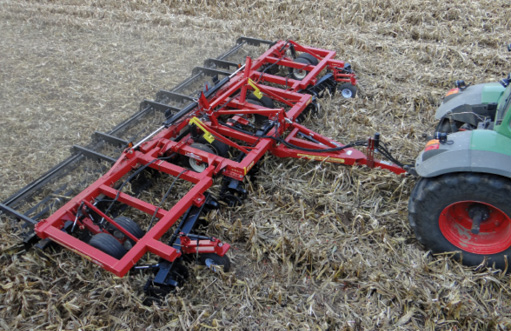
The McFarlane SPR1000 vertical tillage seedbed conditioner was arguably the first vertical tillage tool. It was designed to do light tillage without creating a stratification layer. However, some customers required a machine capable of moving more soil and creating a looser seedbed. This resulted in the invention of the Reel Disk in 2007 (shown here). This machine added a single gang of low concavity blades with low disc angle to provide the option of attaining vertical tillage at the lower 5 and 7.5 degree disc angles while still offering angle adjustment up to 13 degrees for circumstances where more leveling is needed (i.e. deep combine tracks, shallow ruts, etc.).
What it isn’t is a disc with 2 gangs of concave blades set at 18 degree angles that will contact 100% of the soil. While these machines may be effective for residue management, they are not vertical tillage.
VT discrepancies: These discrepancies come from the fact that many manufacturers never understood the concept of vertical tillage before designing their machine. Early vertical tillage machines had straight coulters or no blades at all, which created little or no soil density layers, but also did not move enough soil or bury the desired amount of residue. As designs progressed, many machines used a rippled coulter or a slightly concave blade, which improved residue handling while maintaining a limited soil contact area.
For many growers it becomes a trade-off between residue management and vertical tillage. Many of the articles written about vertical tillage have actually been about residue management. Many new products have entered the market in recent years, and some are conventional tillage machines that were converted to better manage residue. Unfortunately, these products have been labeled as vertical tillage tools rather than residue management machines. The term “vertical tillage” became vastly overused. A standard angle disc is not a vertical tillage machine no matter how one tries to disguise it. The old adage holds true, “If it looks like a duck, walks like a duck and quacks like a duck, it’s a duck.” In this case “If it looks like a disc, it’s a disc.”
Thurston Manufacturing
The original and most broad definition of vertical tillage includes any type of tillage machine that does not move the soil from side to side, and therefore does not create a horizontal soil layer. Under this definition, these tools would include chisels, in-line rippers and straight blade coulter machines. Fundamentally, any ground engaging tool that only moves the soil vertically would qualify as a vertical tillage machine. With this, it can be said that some farming operations have literally been practicing vertical tillage for decades. After the vertical tillage term was coined however, the marketplace began to respond and the higher speed straight blade coulter machines were clearly the focal point.
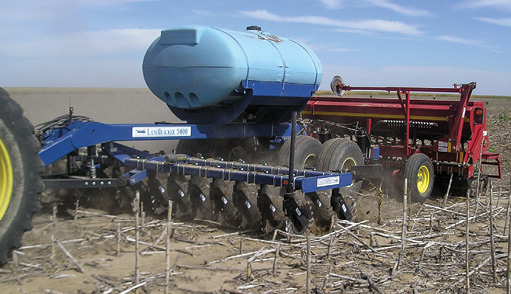
BLU-JET CoulterPro, when combined with the LandTracker 9400 Implement Caddy, can allow the producer to size residue and apply liquid fertilizer in a combination pass with a 3-point planter or no-till drill.
As straight blade coulter machines began to gain popularity by demonstrating higher speed operation at wider widths, a migration away from the original vertical tillage definition began to take shape. These machines gave rise to the belief that a vertical tillage machine qualified as such if it used a blade as the primary soil engaging tool, had the ability to be operated at higher speeds and employed leveling tools such as baskets and harrows. These straight blade tools do qualify under the original definition of vertical tillage, and took center stage while leaving machines like chisels and in-line rippers in lesser supporting roles of the vertical tillage practice.
A third type of machine entered this marketplace once the concept of the vertical tillage tool had morphed into one that was perceived as using only blades, and running at a higher speed, while leveling the soil. These tools are best classified as high speed discs and are usually called “compact discs.” Normally, these employ a series of concave blades that can be run at varying angles. These tools also use a series of baskets or harrows to perform a leveling operation. They appeared at a time where the residue management marketplace was demanding a “vertical tillage” tool that buried more residue. These tools completely abandon the original definition of vertical tillage, as most move soil from side to side and some have shown the propensity to create a horizontal layer within the soil. (See discussion of compact discs later on in this report.)
VT discrepancies: When you consider the way in which the definition of vertical tillage has changed in the past few years, it becomes clear why the definition of the practice can vary so greatly among different farmers. In fact, there is not a singular standard within the industry that defines the vertical tillage practice. Unfortunately, we have the manufacturers of farm equipment in part to thank for the blurred definition, as many have introduced new tools under the guise of vertical tillage that would not have qualified under the original definition.
The way in which the original definition of vertical tillage has changed within the marketplace has lead to great confusion among farmers and equipment retailers alike when it comes to finding the tool that will meet a producers needs. As a result, it is imperative when speaking about vertical tillage to identify the main objective of the operation. Some of these objectives may include breaking up compaction layers at varying depths, to smooth out areas of the field from tire tracks or water erosion, to cut and size residue, or to improve rainfall penetration by breaking up a surface crust.
EarthMaster
What is VT? Vertical tillage is surface or shallow tillage that helps growers manage crop residue, control or minimize potential erosion and prepare a clean, level seedbed. Vertical tillage tools generally do not use horizontal sweeps or plow shares, providing improved tilth, improved soil aeration and enhanced water infiltration with minimal soil disturbance by using coulters, low concavity discs or some type of spike mechanism.
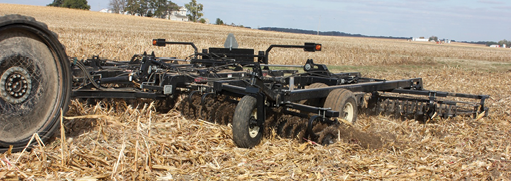
The new 3000 Series vertical tillage tools from EarthMaster use low concavity SoilRazor blades to cut and capture residue. The blades, with their saw tooth profile and cutting edge on the side of the blade stay sharp longer, providing better residue sizing over more acres. The gangs of blades are mounted at 18 degrees causing just enough dirt movement to pull up root balls and to mix the cut residue with soil, capturing it on the surface.
VT discrepancies: There are a lot of variables in soil types, plant populations, and changing terrains that affect a machine’s ability to perform effectively. People in the tillage companies also have lots of ideas on how best to solve the problems of managing residue, minimizing erosion and preparing a seedbed, so manufacturers try what they believe to be the best of those ideas as they attempt to gain competitive advantage. Some manufacturers have viewed vertical tillage as an extension of existing product lines, so they design and build their vertical tillage tools on the same platform as one of their existing products to aid flow through their manufacturing plants. Other companies looked at ideas that have worked in other parts of the world, particularly Europe, and have designed their products to match that style. We at EarthMaster examined the problems our customers face each year and developed a tool that we believe to be the most effective solution in a broad range of soil types and operating conditions.
Kuhn Krause
What is VT? Agronomically speaking, vertical tillage is any tillage operation that does not cause a horizontal shearing or smearing plane in the soil profile, which could potentially lead to a soil density change within or below the tillage operation. This could be deep or shallow operation, but most common is shallow vertical tillage designed to assist in the management of residue while mixing soil to create a seedbed promoting residue decomposition into organic matter. The depth of operation for shallow vertical tillage is usually determined to be no deeper than the planting depth of the seed in order to avoid a potential change in soil density. Abrupt changes in soil density can lead to delays in plant root development, thus slowing the growth and productivity of the plant. To this end, most vertical tillage equipment is comprised of vertical cutting blades at no angle or very shallow angles.
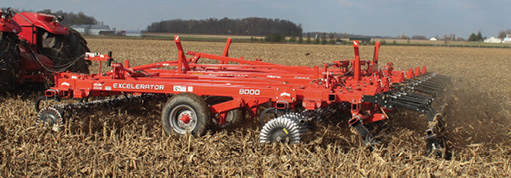
The Kuhn Krause Excelerator Vertical Tillage System accomplishes the agronomic definition of vertical tillage by managing high volumes of residue, creating an ideal seedbed and not producing a horizontal layer in the soil profile. The blade uses an aggressive serrated edge to slice tough residue, penetrating the soil 1.5-3 inches deep. The 32-flute shallow (0.25 inch) concavity blade produces small clod size and provides just enough lateral soil movement to mix residue and begin the soil leveling function.
Vertical tillage does not involve inverting or “rolling” the soil during the tillage process. True vertical tillage is more closely described as “sliced and lifted” rather than “sheared” in the process. Vertical tillage is not equipment with common concave discs or traditional sweeps, which may produce a horizontal shear plane below the depth of planting.
VT discrepancies: Many manufacturers are not playing by the same set of rules concerning vertical tillage. For instance, some are using common disc blades on a variety of gang angles (10, 17 or 21 degrees) in configurations very similar to conventional disc harrows, or even on disc harrow frames, claiming the machines to be “vertical tillage.” Unlike Kuhn Krause, this is all in an effort to market equipment with minimal investments from engineering and manufacturing, disregarding the practice of true vertical tillage.
Still, other manufacturers are introducing “new machines” to the North American market, trying to convince farmers that the compact disc harrow is a “vertical tillage” machine in order to take advantage of the vertical tillage buzz. At the same time, this provides a wide array of machines through “artistic license” and gives customers many choices in the market. Most will find machines that fit their operation based on function and performance rather than pre-defined terminology.
Salford Group
What is VT? True vertical tillage involves managing soil density and making a conscious decision to eliminate horizontal density layers, or “plow pan” that can be a serious yield limiting factor. The goal of managing soil density and removing horizontal density layers is to improve crop performance because of a better seedbed and access to moisture and nutrients. In this way, vertical tillage should be considered a set of practices rather than any one machine. Vertical tillage systems should manage the whole soil profile from the surface, including residue and the seedbed, down through the topsoil into the subsoil.
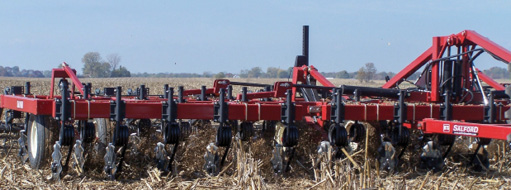
Salford’s high clearance vertical tillage machines are designed to prepare seedbeds at high speeds in a greater range of soil moisture and residue conditions. Like other true vertical tillage implements, it uses wavy coulters that enter straight into the ground. By putting wavy blades straight into the ground these vertical tillage tools remove compaction layers in the seedbed even when running in damp soil. The wavy blades, mounted on 5 or 7.5 inch spacing, lift some soil on top of the residue, which speeds up soil warming and residue decomposition.
True vertical tillage implements have shanks and/or blades that engage the ground straight up and down with little or no angle to the soil surface. This reduces the chances of leaving secondary compaction layers created by horizontal forces. Straight shanks manage soil density to improve aeration and moisture storage deeper in the soil profile, while surface tillage equipment helps to manage residue and soil density at the surface. Aside from selecting the right tool(s) for vertical tillage, soil moisture when doing fieldwork, tire pressure, number of field passes and managing soil organic matter, as well as soil aggregation and soil structure must be considered.
VT discrepancies: The term “vertical tillage” has become confused with “surface tillage and residue management.” Although vertical tillage can include surface tillage and residue management, it must also include density management. The first manufacturers to build true vertical tillage units paid very close attention to the goal of soil density reduction to improve root development. In contrast, many new “vertical tillage” designs are disc harrows refitted with low concavity blades and renamed. The low concavity blades are excellent for surface leveling, residue sizing and some weed control. They also allow the disc harrow to run almost as fast as vertical tillage tools without ridging.
Where discs and vertical tillage tools differ is in density reduction. The backside of concave blades put horizontal pressure into the soil, and as the gangs of blades pass through the soil, they generate waves of pressure under the tool. Blades mounted on angles also don’t roll as freely through the ground and when these angled blades drag across the field surface they cause additional compaction. The shallow operation of these high speed discs tends to bury large amounts of residue in the seed zone, which can negatively impact planter performance and increase disease pressure.
Summers Manufacturing
What is VT? Vertical tillage is best defined as a tool that enters and exits the soil on a vertical plane as opposed to any tool that travels on a horizontal plane. Vertical tillage is beneficial for cutting and sizing residue while mixing it with soil to convert it into organic matter for healthier soils and a more uniform and receptive seeding environment. Vertical tillage tools will run in wet soil and can help warm up cold soil for quicker, more uniform seed emergence.
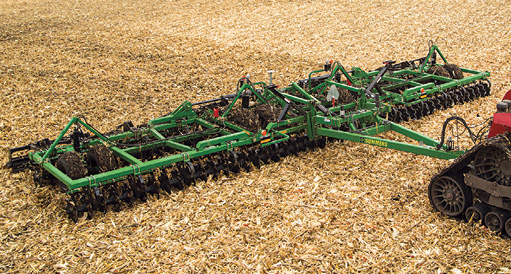
The Summers SuperCoulter Plus is a true vertical tillage tool that uses two gangs of coulter blades traveling straight in line with the direction of travel without any horizontal travel. Different types of blades for a variety of uses and requirements are offered. The patented hydraulic hitch allows the operator to adjust the emphasis from front to rear gangs for varying field conditions. Gang mounting of the blades ensures uniform operating depth that is immediately apparent when used ahead of shallow seeded crops.
Another major benefit of vertical tillage is the fracturing effect in the soil profile. True vertical tillage doesn’t force the soil to “break” unnaturally. True vertical tillage “scores” the soil similar to cutting glass and allows for natural fracturing. Eliminating soil layers allows roots to access nutrients and moisture previously unavailable producing more vigorous and productive plants.
True vertical tillage does not travel on a horizontal plane so concave blades, or blades that don’t maintain a straight line of travel through the soil are not vertical tillage. True vertical tillage is also not intended for complete weed control and probably wouldn’t be practical for organic farming operations. Shallow rooted weeds can be eliminated in wet loose soils, but in dry, firm soils, deep rooted weeds are beyond the capabilities of true vertical tillage.
VT discrepancies: Wet, late spring conditions with heavy and/or difficult residue conditions have presented varying and unusual conditions for many growers. Vertical tillage can’t always be the complete answer for every situation. Sometimes heavy residue and wet soil conditions are better handled with more aggressive tillage that will move more soil and increase the blackening effect on the field finish. Summers Mfg. builds tools that operate in wet conditions, cut and bury residue and provide a level seedbed. Because the blades are concave and operate at an angle, they are NOT vertical tillage and we don’t advertise them as such. Many claims of so called vertical tillage tools seem to be trying to capitalize on the vertical tillage bandwagon and probably aren’t in the best interest of helping to inform and assist a grower in choosing the best tool for their particular operation.
Great Plains Manufacturing
What is VT? Vertical tillage always works the ground vertically vs. conventional tillage that “shears” the ground in horizontal layers. A disc shears the ground 6 inches deep. Above the sheared surface it is firmer. Likewise, a field cultivator or “one-pass” tool with sweeps will shear the ground 4 inches deep. Above is looser and below is firmer. This density change restricts the root system, especially on grass crops like corn and milo. At that point, the producer is limited to growing a corn crop in a 4 inch “flower pot.”
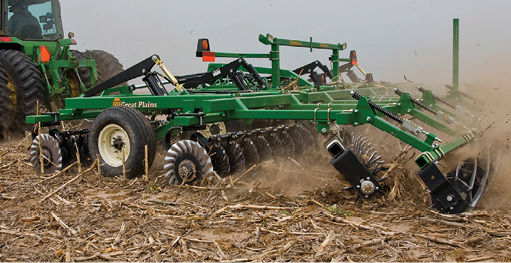
Great Plains offers three vertical finish tools: Turbo-Till, Turbo-Chopper and Turbo-Max. All vertical finish tools must do three things: maintain uniform density; size residue; and provide a “PERFECT” seedbed for the planter. Turbo-Till (shown here) is preferred by no-tillers because, while it is a perfect residue manager, it buries “0” residue.
The goal of vertical tillage is to “reset” the soil profile as deep as is practical. In shallow top soils, this may mean 8-10 inches and in much of the Cornbelt, 15-16 inches after it is “reset.” The object is to not put any density change layers back in. The result is producing a corn crop in a 15 inch “flower pot” vs. a 4 inch “flower pot.” Vertical tillage is not a “high speed disc” with concave blades running at an angle 2 inches deep.
VT discrepancies: 90% of the so-called vertical tillage tools are actually high speed discs. Their only goal is to manage residue. They totally ignore maintaining uniform density and creating a perfect seedbed. Vertical tillage is not one tool running fast and shallow with concave blades and gang angle. Vertical tillage is a “system” that resets the soil profile as deep as is practical and then maintaining the density allowing better water infiltration, better root development, better nutrient take up and maximum yield. True vertical tillage is a win-win for the environment as well as the producer. Bottom line: if it has concave blades and gang angle it is NOT vertical.
Environmental Tillage Systems
What is VT? Vertical tillage involves the mixing of soil and residue, typically while incorporating crop nutrients without creating horizontal compaction layers. True vertical tillage lifts soil in a desired seedbed zone leaving the majority of the soil and crop residue undisturbed. It is not the shear and smear action of shank-style tillage that involves concave designed coulters that some major manufactures promote as vertical soil movement. Specially designed vertical coulters of different sizes and shapes engineered into row units with consistent downforce will accomplish vertical tillage at high speeds that accentuates the nutrient mixing action while maintaining soil structure and aggregation for increased water infiltration and reduced erosion.
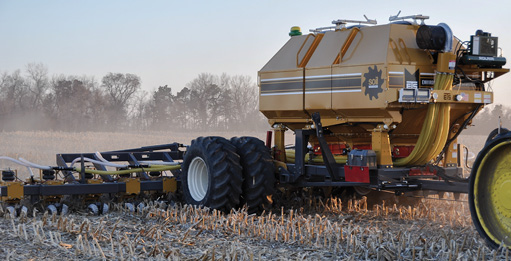
Environmental Tillage Systems SoilWarrior brand of vertical tillage surgically incorporates fertilizer while building a moisture-correct seedbed utilizing the patented Cog Wheel for deep tillage in the fall and the XS attachment in the spring. The SoilWarrior X row unit features high psi air spring downforce with parallel linkage ensuring that each row maintains a consistent depth. The 30 inch Cog Wheel has 20 inches of travel to roll up and over obstacles like rocks.
VT discrepancies: Many discrepancies exist among U.S. manufactures due to lack of leadership and commitment to innovate like European companies in the environmental tillage segment. Perhaps the reason revolves around conflicting product lines that serve existing customer demand and provide high volume revenues for horizontal/conventional tillage equipment. In addition, the industry lacks complete hitch-pin ready environmental systems therefore farmers have been driven to build their own vertical tillage solutions without product support and equipment warranties.
HCC Inc.
What is VT? There has been some confusion in the marketplace defining vertical tillage. In some instances, we believe manufacturers have used the term vertical tillage as a marketing term. Vertical tillage to HCC is defined as fracturing the soil, a method of sizing residue, covering the residue with soil and breaking up compaction.
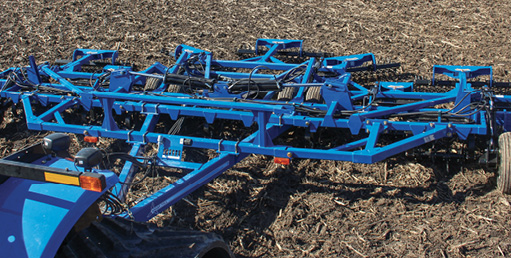
The HCC SMART-TILL was introduced 8 years ago as a tool that can be used in the spring as well as in the fall. In the spring, the tines fracture the soil more than 8 inches deep with little surface disturbance. This creates improved air and water exchange, which offers many benefits and allows a farmer to get into the field sooner to plant. In the fall, it is use for residue management. The tines fracture the soil and break up corn stalks and other residue.
Many traditional tillage tools are designed to work only the top 2 inches of the soil and operate at much slower speeds. The HCC SMART-TILL consists of a tine that fractures the soil more than 8 inches deep. The rotary harrows, which are an integral part of the tool, break up clods and help pin residue to the soil. To maximize its performance, it should be pulled at operating speeds of 8-10 mph.
VT discrepancies: There’s little doubt that the term “vertical tillage” has been confusing. SMART-TILL has been classified as a vertical tillage tool, but we want farmers and ranchers to look at it more as a soil management tool because it has features and benefits for both spring and fall soil management applications.
Case IH
What is VT? A consensus definition of the term “vertical tillage” has proven to be elusive, and operationally has been defined by manufacturers of various types of equipment. Unlike field cultivators, that produce more soil leveling and, generally, more soil surface disturbance, we define effective vertical tillage (VT) as: loosening the soil, using ground-engaging components perpendicular to the soil, to increase pore space between soil particles without creating a horizontal compaction or “smear” layer. Such layers are often created by backside pressure from concave blades or by field cultivator sweeps.
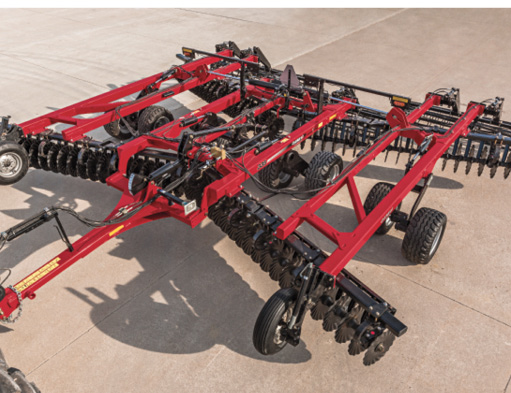
Case IH introduced the True-Tandem VT in 2007. The tool features an all-rotary design. Built on a disc harrow frame, two rows of ganged blades work in tandem to perform tillage and size/mix residue. Gangs are fixed at the perfect angle to avoid compaction-creating backside pressure on the blades. The blade has shallow-concavity with a rippled wave edge that explodes soil upward and outward. This upward and outward tossing of soil is what acts to level the soil surface, which other types of vertical tillage are unable to do. It is designed to run between 7–9 mph.
Instead, VT uses coulters or shallow-concavity blades to level and loosen the soil without turning the soil over. While there is some measure of cutting (sizing) of residue, soil contact is shallow, generally running in the top 1-3 inches only. As a result, VT operates at a faster pace and creates less disturbance than a field cultivator. The surface of the soil should be left more level than before the tillage, with high spots leveled off and valleys filled. VT operations may be run in fall and/or spring.
VT discrepancies: Manufacturers in the North American market truly present a number of different approaches to vertical tillage. They work well in one particular soil type and crop and within a narrow weather pattern. Broad, major field studies are often absent.
Landoll Corp.
What is VT? Vertical tillage is a process that begins in the fall, where the soil density is “reset” through the use of a deep tillage tool, eliminating any density changes that exist throughout the soil profile. Then, when the seedbed is prepared for planting, the depth of the tool is limited to not working any deeper than what the seed for the intended crop will be planted. A seed will thrive if it is placed in the same density of soil that it will be growing in through its life cycle. By working too deep prior to planting, or if the soil density was not reset after the previous harvest, the roots from the growing seed will sense these density changes and can cause a reduction in yield.
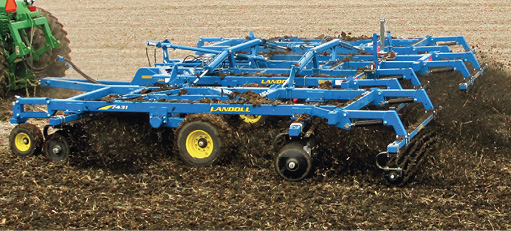
Because vertical tillage is a process, the tools that could be used in the fall for resetting soil density, would be Landoll’s Zone Commander/In-line Ripper, Coulter Chisel, Ripoll and Weatherproofer. If a producer’s soil density is in good shape, the VT Plus can be used to size and anchor residue. For seedbed preparation or spring tillage, the VT Plus would be the tool of choice. It utilizes an ultra-shallow concavity 22 inch diameter blade on 7 inch spacing. The gangs are on a pre-determined angle to provide the proper amount of soil and residue mixing. Gangs set at a lesser degree will not provide enough movement of soil for leveling ruts or tire tracks. Lateral movement of soil is imperative in anchoring residue so that it is not susceptible to erosion from wind and water.
VT discrepancies: There are as many variations of the correct performance of vertical tillage tools as there are tools themselves. The bottom line is the end result or the finished product is basically the same for all (or should be): consistent soil density in the growth and root profile of the field. How the many different machines achieve this is where the discrepancies arise. Some machines meet end users’ expectations better than others. Some soil conditions or crop rotations favor one design over another. We believe the many benefits of vertical tillage sometime clouds the concept of the machines, but still offers the producers benefits such as, earlier soil warm up, residue management, weed control, moisture control (dry or conserve), higher speed tillage and field leveling. So take your pick of the benefits. They’re doing what customers want.
Kongskilde Industries
What is VT? Vertical tillage is designed to achieve in one pass, a level seedbed with some soil movement in the top 1-3 inches, as well as size and incorporate residue, which speeds up the breakdown of the residue, soil warming and drying in the spring. For some fall applications, such as after soybean harvest, it can be used to prepare the soil for planting winter wheat. It is of particular benefit to the farmer who is working in a no-till or min-till application and doesn’t want to disturb the soil texture very deeply, which maintains a firm base that is very helpful in a wet year for the fall harvest season. There are many manufacturers with many different designs accomplishing this to some degree.

The Kongskilde 9100 Vertical Tillage Machine has 5 different gang angle adjustments from 0-16 degrees front and back, which allows it to achieve working depths from 1-6 inches. This allows the unit to do primary and secondary tillage with one machine, which is unique in the vertical tillage industry. It utilizes 20 inch diameter self-sharpening saw tooth VT razor blades that have a 1.5 inch concavity.
Vertical tillage was not designed to replace deep tillage or plowing, which generally works from 8-12 inches deep.
VT discrepancies: When vertical tillage first started, there were two or three companies using a straight blade with a ripple or wave in it, and these ran in a straight line front to back, and did very little to incorporate the residue. They would provide some soil movement in lighter soil types and would size residue. It soon became evident that this was not sufficient. The new Bt corn varieties are much tougher and with the higher yields there is much more residue. It also soon became evident that more dirt had to be mixed with the residue for quicker break down.
There were also issues with control of slugs particularly in soybeans as they thrive where there is lots of residue. Today, most farmers want more of the residue incorporated with the soil, which helps control the pests, helps keep the residue in the field and out of the ditches, and speeds up the residue breakdown. With the high cost of equipment farmers are looking for a machine that will do more than one thing. That is why Kongskilde designed the 9100 vertical tillage machine the way it is, so we could achieve primary and secondary tillage in many soil types and many different types of residue conditions.
Maschio
What is VT? Vertical tillage (VT) equipment is used to shallowly till the soil, mixing and chopping residue into the topsoil. True VT machines apply no angle coulters/discs/blades running in the same direction of the tractor without producing a horizontal trimming in the soil profile, which leads to a soil stratification. However, the present market is asking for tools with multiple high angle discs able to manage residues and refine seedbed in one effective pass. These machines perform as tools for residue management and they cannot be simply categorized as vertical tillage machines.
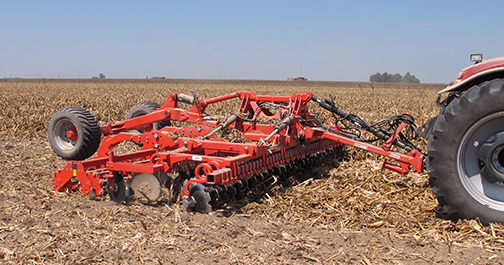
MASCHIO designed a complete range of speed discs called UFO. This is a multi-dimensional, one-pass tillage implement to accomplish several actions in the field (e.g., residue sizing and blending, soil bacteria activation, finishing). The 24-inch discs of the UFO allow it to operate much faster than the traditional tillage tools. In fact, it works best at speeds from 8-12 mph, leading to significant fuel and time savings.
VT discrepancies: VT tools demand is growing faster and faster in the market. Tillage manufacturers developed VT tools on their own existing product range in order to fit the increasing request for the fastest and cheapest way. So they build their VT equipment, often suitable for running in a specific working conditions with particular soil and crop.
Sunflower
What is VT? Vertical tillage has become one of the more popular approaches to utilizing a full growing season in climates where getting into the field early in the spring can be a challenge. Due to cold, damp, soils and the tough physical structure and sheer volume of residue from new plant hybrids, special equipment needs to be used to meet these demands. For plants to achieve the maximum potential bred into them, they need even soil temperatures and consistent moisture content throughout the vertical soil profile. Vertical tillage achieves this sizing and mixing of plant residue in only the very upper layers of the soil profile, and provides enough clean surfaces to absorb sunlight and evenly warm the upper 2-3 inches of soil.
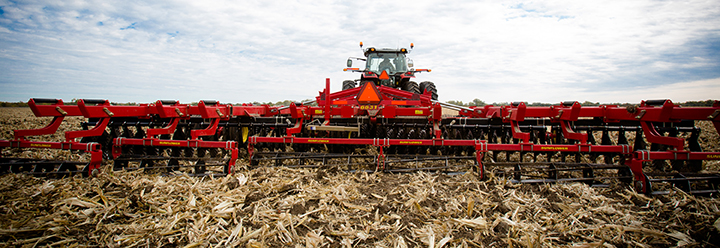
The 6631 is designed for surface tillage and residue control. The high performing Saber Blade is exclusive to Sunflower, and is one of the most exciting tillage innovations in years. This unique combination of low concavity, 25 perfectly sized flutes and the serrated “saw tooth” edge works the soil like no standard blade can. The blade is extremely well suited for cutting through the toughest of residue, penetrating the soil and eradicating weeds. The Sunflower Saber has excellent clod-crushing capabilities at normal working speeds and yields excellent performance in soft soils. As the cutting edge wears, it actually maintains an aggressive cutting edge. The Sunflower Saber Blade continues to work season after season, cutting heavy residue long after standard blades have dulled beyond effectiveness.
VT discrepancies: Several first generation tools are now attempting to incorporate some gang angle into their tool designs to address the failure of their designs to anchor crop residue. While still using flat coulter blades, these manufactures are adding adjustability to the gang assemblies achieving gang angles of 5 or more degrees to move soil horizontally. These low gang angles are proving to be insufficient to properly anchor the crop residue.
Other manufactures are focusing on higher operating speeds. Their tools are designed with compact frames and smaller diameter concave disc blades. These tools perform well in light crop residue but do not handle heavy corn residue very well. Their conventional “notched disc” blades, like other non-serrated blades, can dull quickly in today’s heavy crop residue.








Post a comment
Report Abusive Comment